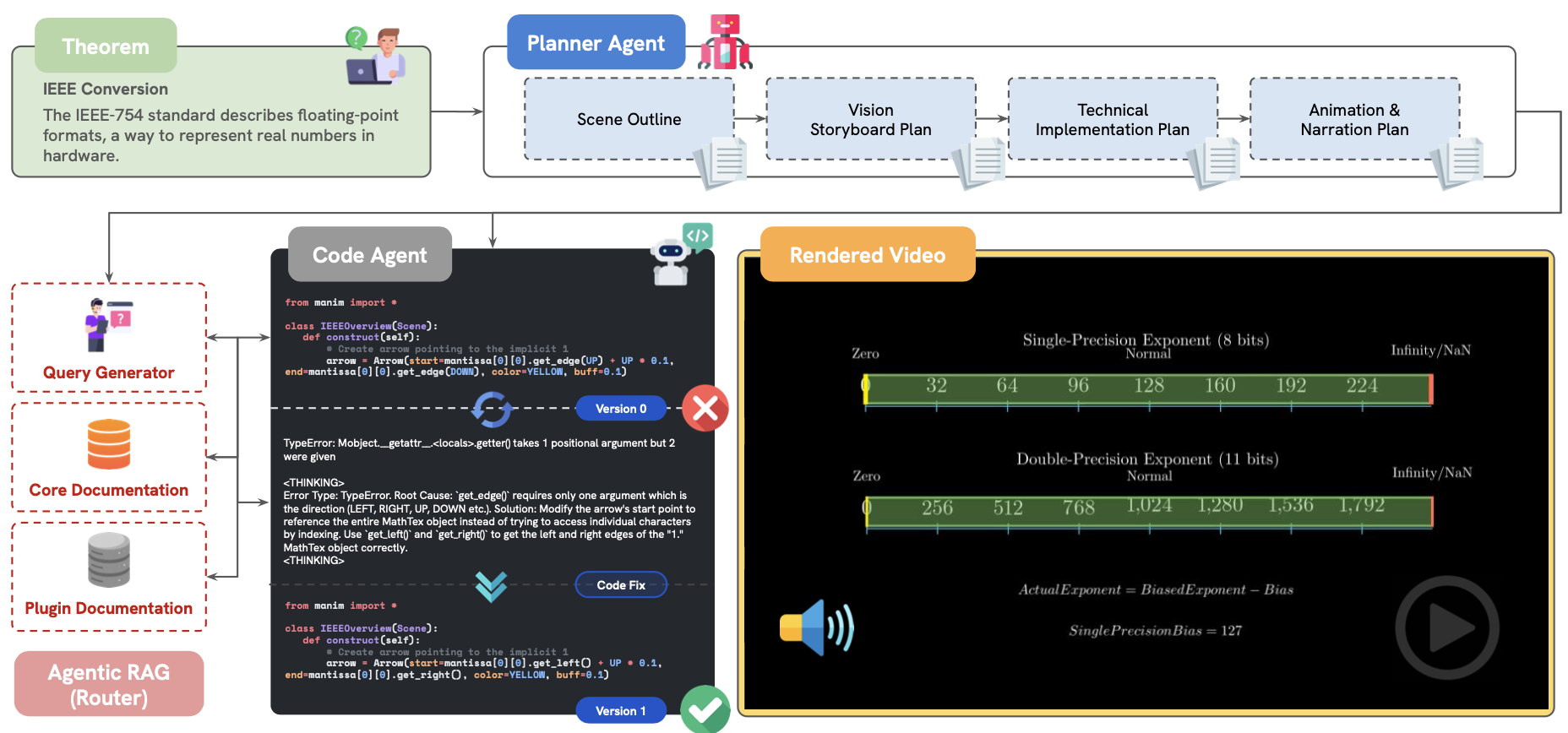TheoremExplainAgent
by University of Waterloo, Votee AIWhat is TheoremExplainAgent?
TheoremExplainAgent (TEA) is an open-source multimodal agent system developed by the University of Waterloo, Votee AI, and other institutions. It generates long-form animated videos to help people better understand mathematical and scientific theorems. TheoremExplainAgent supports the creation of educational videos over 5 minutes long, covering various STEM fields such as mathematics, physics, chemistry, and computer science. To evaluate performance, researchers introduced the TheoremExplainBench (TEB) benchmark dataset, which contains 240 theorems assessed across multiple dimensions including accuracy, depth, logical flow, visual relevance, and element layout. Experiments show that TheoremExplainAgent excels in generating long-form videos, revealing deep reasoning errors often missed in text explanations, and providing new insights for AI-generated educational content.
Main Features of TheoremExplainAgent
- Generates Long-Form Videos: Creates explanation videos over 5 minutes long based on input theorems, covering subjects like mathematics, physics, chemistry, and computer science.
- Multimodal Explanations: Combines text, animations, and voice to enhance understanding of abstract concepts through visualization.
- Automatic Error Diagnosis: Exposes reasoning errors through video format, helping developers diagnose logical flaws in models more clearly.
- Cross-Disciplinary Applicability: Supports theorems of varying difficulty levels (from high school to graduate level) and is applicable across multiple STEM fields.
- Systematic Evaluation: Uses the TheoremExplainBench benchmark and multi-dimensional evaluation metrics to systematically measure the quality and accuracy of generated videos.
Technical Principles of TheoremExplainAgent
- Planning Agent: Responsible for generating the overall plan for the video based on the input theorem, including scene division, goals for each scene, content description, and visual layout.
- Chain-of-Thought and Program-of-Thought Techniques: Ensures logical coherence and depth in video content.
- Coding Agent: Uses Manim (a Python library for creating mathematical animations) to generate animation scripts based on the detailed plan from the planning agent. Employs Retrieval-Augmented Generation (RAG) technology to dynamically retrieve code snippets and API documentation from the Manim documentation, improving code generation accuracy and efficiency. Automatically detects and fixes errors during code generation to ensure correct video rendering.
- Multimodal Fusion: Combines text narration, animation demonstrations, and voice explanations to enhance understanding of theorems through visualization. Uses image processing techniques and natural language processing models (e.g., GPT-4o and Gemini 2.0 Flash) to evaluate the generated videos across multiple dimensions, ensuring content accuracy and visual quality.
- Systematic Evaluation: Introduces the TheoremExplainBench benchmark, which contains 240 theorems covering multiple disciplines and difficulty levels. Includes five automatic evaluation metrics (accuracy, visual relevance, logical flow, element layout, and visual consistency) to comprehensively measure the quality of AI-generated videos.
Project Links for TheoremExplainAgent
- Project Website: https://tiger-ai-lab.github.io/TheoremExplainAgent/
- GitHub Repository: https://github.com/TIGER-AI-Lab/TheoremExplainAgent
- HuggingFace Model Library: https://huggingface.co/datasets/TIGER-Lab/TheoremExplainBench
- arXiv Technical Paper: https://arxiv.org/pdf/2502.19400
Application Scenarios of TheoremExplainAgent
- Online Education: Provides students with vivid theorem explanation videos to assist in online learning.
- Classroom Teaching: Serves as a teaching aid for educators, enhancing students' visual learning experience.
- Academic Research: Helps researchers quickly understand complex theorems and generate accompanying research videos.
- Technical Development: Generates explanation videos for algorithms and models, aiding engineers and technicians in understanding principles.
- Science Communication: Creates science communication videos for the public, improving the effectiveness of science dissemination.
Features & Capabilities
- Online Education
- Classroom Teaching
- Academic Research
- Technical Development
- Science Communication
Getting Started
Screenshots & Images


